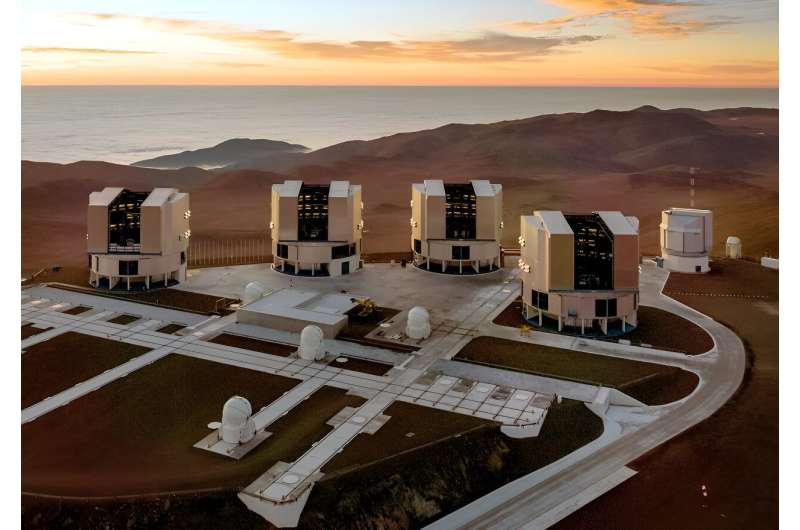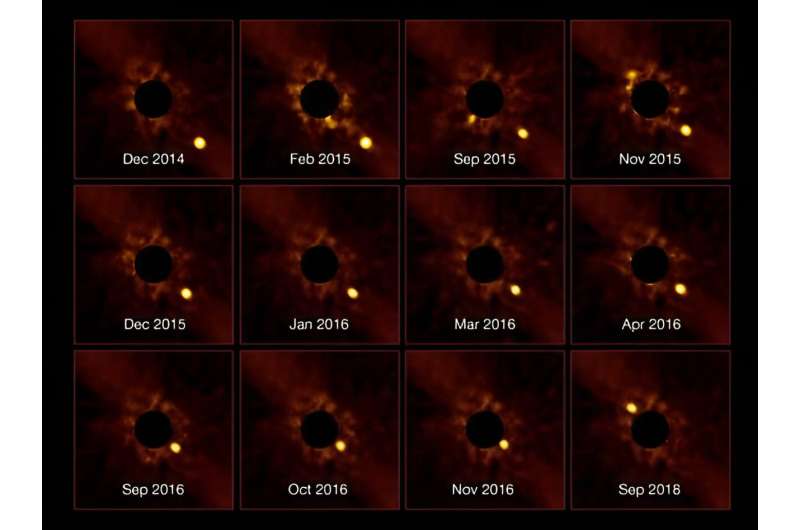This article has been reviewed according to Science X's editorial process and policies. Editors have highlighted the following attributes while ensuring the content's credibility:
fact-checked
peer-reviewed publication
trusted source
proofread
A new planet-hunting instrument has been installed on the Very Large Telescope

Exoplanet studies have come a long way in a short time. To date, 5,523 exoplanets have been confirmed in 4,117 systems, with another 9,867 candidates awaiting confirmation. With all these planets available for study, exoplanet researchers have been shifting their focus from detection to characterization—i.e., looking for potential signs of life and biological activity (biosignatures).
Some major breakthroughs are expected in the coming years, thanks in part to next-generation observatories like NASA's James Webb and Nancy Grace Roman Space Telescope and the ESA's PLAnetary Transits and Oscillations of stars (PLATO) mission.
Several ground-based facilities will also be vital to the characterization of exoplanets, like the Extremely Large Telescope (ELT), the Giant Magellan Telescope (GMT), and the Thirty Meter Telescope (TMT). But there are also existing observatories that could be upgraded to perform vital exoplanet research.
This idea was explored in a recent paper by an international team of astronomers, who presented the first light results of the High-Resolution Imaging and Spectroscopy of Exoplanets (HiRISE) recently installed on the ESO's Very Large Telescope (VLT)—not to be confused with the High-Resolution Imaging Science Experiment camera on NASA's Mars Reconnaissance Orbiter (MRO).
The study was led by Dr. Arthur Vigan, a permanent researcher with the Centre Nationale Reserches Scientifique based at the Laboratoire d'Astrophysique de Marseille. He was joined by researchers from the European Southern Observatory (ESO), the National Institute for Astrophysics (INAF), the Academia Sinica, the Ecole Normale Supérieure, the UH Institue for Astronomy, the Space Telescope Science Institute (STScI), and multiple universities and laboratories. A preprint of their paper recently appeared online and is being reviewed for publication by the journal Astronomy & Astrophysics.
Exoplanet research has been moving into characterization thanks to improvements in instrumentation and machine learning. With such a large sample of planets, scientists are now characterizing individual planet atmospheres and can draw statistical conclusions on large samples. These improvements are also leading to a transition in terms of methods, where exoplanets are being studied using direct imaging more than ever before. This method consists of detecting exoplanets by imaging the light reflected from their atmospheres and surfaces.
This stands in contrast to indirect methods like transit photometry or Doppler spectroscopy (aka the transit method and radial velocity method), which have been responsible for the majority of exoplanet detections and confirmations so far. A major benefit of direct imaging is that astronomers can examine the reflected light using spectrometers to determine the chemical composition of an exoplanet's atmosphere. Said Dr. Vigan via email:
"Detection of these objects and measuring accurate spectra is still quite challenging because they are typically at extremely small angular separation from their host star and with a huge difference in brightness. A classical analogy is that of trying to image a candle located 1 m apart from a lighthouse when you observe from 700 km away! In the field of direct imaging, the combination of high-contrast imaging, which enables the detection of these planets, with high-resolution spectroscopy is a really hot topic right now. This is exactly what HiRISE enables on the VLT."

The HiRISE instrument is designed to characterize extrasolar giant planets (EGPs) in the infrared H band, an atmospheric transmission window astronomers use to measure the absorption by water vapor, volcanic activity, and other atmospheric phenomena. It combines the Spectro-Polarimetric High-contrast Exoplanet REsearch (SPHERE) imager with the recently upgraded high-resolution CRyogenic high-resolution InfraRed Echelle Spectrograph (CRIRES) using single-mode optic fibers. The addition of this instrument will greatly enhance the VLT's imaging capabilities, which are currently limited in terms of spectral resolution relative to other observatories.
This is particularly the case for SPHERE, said Dr. Vigan, which is dedicated to finding exoplanets via direct imaging but has a maximum resolution of just ~70. "Other instruments like SINFONI (retired) or now ERIS provide higher resolutions, but they are not really optimized for exoplanet imaging, and GRAVITY provided some great results with interferometry, but except in a few cases, it is limited to a resolution of a few hundred," he said. "By contrast, HiRISE enables a resolution of 100,000! This opens the door to much more detailed spectral characterization and to measuring dynamical parameters such as the speed at which these planets orbit around their star and how fast they spin."
In addition to atmospheric characterization, these measurements will help astronomers investigate EGP formation, composition, and evolution, addressing some significant mysteries and helping astronomers refine their models for solar system formation. Based on the first light collected using the new HiRISE instrument, the team demonstrated how its incorporation into the VLT has led to improved astrometry, temporal stability, optical aberrations, and transmission. Moreover, their paper demonstrates how existing instruments and observatories can be upgraded to provide high-contrast imaging or high-dispersion spectroscopy by coupling them using optical fibers.
This offers a cost-effective alternative to creating entirely new facilities from the ground up, which is the case with the ELT, GMT, and TMT. As these examples have demonstrated, the creation of new facilities is expensive, subject to delays, and can generate controversy when it comes to where facilities are being built (sensitive ecosystems, protected environments, Indigenous land, etc.). As Dr. Vigan explained:
"Designing, manufacturing, testing, and installing a brand new instrument on a large ground-based telescope is both long and costly: 10 years and ~20 million euros (including 10 million in hardware) for the SPHERE instrument on the VLT. This is even without taking into account that you need an available focus on the telescope for the new instrument. The advantage of coupling existing instruments is that you can go much faster and much cheaper while still making a great instrument that benefits from existing ones."
In the case of HiRISE, he added, it took about five years of development and cost around €1 million ($1.16 million), including €200,000 to pay for the hardware and labor costs. In contrast, the European Southern Observatory placed the cost of building the ELT at $1.5 billion in 2020 (€1.42 billion). This was after the ESO approved a budget increase of 10%, and the facility will not be completed for several more years. Meanwhile, Dr. Vigan and the ESO hope to commence observations with the upgraded VLT by November, which will serve as a pathfinder for other observatories:
"Hopefully, HiRISE will pave the way for future instruments, for example on the extremely large telescopes (ELTs). We have learned a lot while designing the instrument and we will now investigate its limits. The European ELT built by ESO will at some point have an exoplanet imaging instrument aiming at the detection of Earth analogs around nearby stars. It's already foreseen that the instrument will include a high-resolution spectroscopy mode to help boost the detection. Everything we have done and learned with HiRISE will be a great starting point."
More information: A. Vigan et al, First light of VLT/HiRISE: High-resolution spectroscopy of young giant exoplanets, arXiv (2023). DOI: 10.48550/arxiv.2309.12390
Journal information: arXiv , Astronomy & Astrophysics
Provided by Universe Today




















